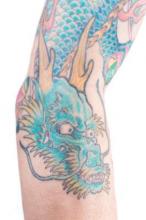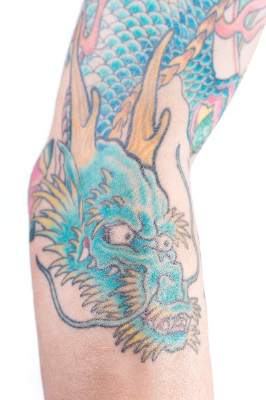User login
HOLLYWOOD, FL. – Tattoos are common, but so are regrets. As tattoos become acceptable for the American mainstream, physicians are seeing more people who, for personal or professional reasons, wish to have a tattoo removed. And those who perform removal procedures benefit from having tools in their toolkit to eradicate an unwanted tattoo with minimal lasting skin damage.
Even with laser therapy – a common and effective tattoo removal technique – blue and green pigments can be especially difficult to eradicate.
At the annual meeting of the American Academy of Cosmetic Surgery, Dr. Robert H. Burke, director of the Michigan Center for Cosmetic Surgery, Ann Arbor, shared results from a pilot study of removal of blue-green pigments with a unique oval-shaped beam from a ruby laser.
Lasers, which preferentially heat chromophores, work well for tattoo removal since a selected wavelength is preferentially absorbed by a particular chromophore, targeting tattooed tissue and sparing non-inked tissue.
Older laser technologies created a Gaussian distribution of intensity with decreasing energy distribution toward the perimeter of the laser field. Newer lasers can create a sharper focal beam, creating beams of different sizes and shapes with uniform intensity.
In the pilot study, four men and four women who had persistent blue-green tattoo colors, received treatment with a 694 nm uniform-intensity ruby laser with an oval beam configuration. The patients, whose mean age was about 31 years, had tattoos with an age range of four to 30 years. The mean age of tattoos was 11.4 years. Most patients had had prior tattoo removal sessions; one of the women had undergone 14 sessions.
Dr. Burke treated these patients two to four times with the oval beam 694 nm ruby laser; fluence ranged from 2-5 J/cm2, with a spot size of 4-6 mm and a cycle of 2Hz.
The average tattoo pigment color clearance achieved with the oval beam 694 nm ruby laser was 60%, with a range from 40% to 90%. The study participants experienced no adverse events, Dr. Burke said.
The oval beam shape, he noted, deserves further investigation, because it should theoretically create less overlap and permit denser treatment – and may also allow the operator to follow a linear tattoo pattern more closely. This particular treatment regimen was also quicker, using 2 Hz rather than the more common 1 Hz, he pointed out.
Dr. Burke reported being on the physician advisory board for Suneva Medical.
On Twitter @karioakes
HOLLYWOOD, FL. – Tattoos are common, but so are regrets. As tattoos become acceptable for the American mainstream, physicians are seeing more people who, for personal or professional reasons, wish to have a tattoo removed. And those who perform removal procedures benefit from having tools in their toolkit to eradicate an unwanted tattoo with minimal lasting skin damage.
Even with laser therapy – a common and effective tattoo removal technique – blue and green pigments can be especially difficult to eradicate.
At the annual meeting of the American Academy of Cosmetic Surgery, Dr. Robert H. Burke, director of the Michigan Center for Cosmetic Surgery, Ann Arbor, shared results from a pilot study of removal of blue-green pigments with a unique oval-shaped beam from a ruby laser.
Lasers, which preferentially heat chromophores, work well for tattoo removal since a selected wavelength is preferentially absorbed by a particular chromophore, targeting tattooed tissue and sparing non-inked tissue.
Older laser technologies created a Gaussian distribution of intensity with decreasing energy distribution toward the perimeter of the laser field. Newer lasers can create a sharper focal beam, creating beams of different sizes and shapes with uniform intensity.
In the pilot study, four men and four women who had persistent blue-green tattoo colors, received treatment with a 694 nm uniform-intensity ruby laser with an oval beam configuration. The patients, whose mean age was about 31 years, had tattoos with an age range of four to 30 years. The mean age of tattoos was 11.4 years. Most patients had had prior tattoo removal sessions; one of the women had undergone 14 sessions.
Dr. Burke treated these patients two to four times with the oval beam 694 nm ruby laser; fluence ranged from 2-5 J/cm2, with a spot size of 4-6 mm and a cycle of 2Hz.
The average tattoo pigment color clearance achieved with the oval beam 694 nm ruby laser was 60%, with a range from 40% to 90%. The study participants experienced no adverse events, Dr. Burke said.
The oval beam shape, he noted, deserves further investigation, because it should theoretically create less overlap and permit denser treatment – and may also allow the operator to follow a linear tattoo pattern more closely. This particular treatment regimen was also quicker, using 2 Hz rather than the more common 1 Hz, he pointed out.
Dr. Burke reported being on the physician advisory board for Suneva Medical.
On Twitter @karioakes
HOLLYWOOD, FL. – Tattoos are common, but so are regrets. As tattoos become acceptable for the American mainstream, physicians are seeing more people who, for personal or professional reasons, wish to have a tattoo removed. And those who perform removal procedures benefit from having tools in their toolkit to eradicate an unwanted tattoo with minimal lasting skin damage.
Even with laser therapy – a common and effective tattoo removal technique – blue and green pigments can be especially difficult to eradicate.
At the annual meeting of the American Academy of Cosmetic Surgery, Dr. Robert H. Burke, director of the Michigan Center for Cosmetic Surgery, Ann Arbor, shared results from a pilot study of removal of blue-green pigments with a unique oval-shaped beam from a ruby laser.
Lasers, which preferentially heat chromophores, work well for tattoo removal since a selected wavelength is preferentially absorbed by a particular chromophore, targeting tattooed tissue and sparing non-inked tissue.
Older laser technologies created a Gaussian distribution of intensity with decreasing energy distribution toward the perimeter of the laser field. Newer lasers can create a sharper focal beam, creating beams of different sizes and shapes with uniform intensity.
In the pilot study, four men and four women who had persistent blue-green tattoo colors, received treatment with a 694 nm uniform-intensity ruby laser with an oval beam configuration. The patients, whose mean age was about 31 years, had tattoos with an age range of four to 30 years. The mean age of tattoos was 11.4 years. Most patients had had prior tattoo removal sessions; one of the women had undergone 14 sessions.
Dr. Burke treated these patients two to four times with the oval beam 694 nm ruby laser; fluence ranged from 2-5 J/cm2, with a spot size of 4-6 mm and a cycle of 2Hz.
The average tattoo pigment color clearance achieved with the oval beam 694 nm ruby laser was 60%, with a range from 40% to 90%. The study participants experienced no adverse events, Dr. Burke said.
The oval beam shape, he noted, deserves further investigation, because it should theoretically create less overlap and permit denser treatment – and may also allow the operator to follow a linear tattoo pattern more closely. This particular treatment regimen was also quicker, using 2 Hz rather than the more common 1 Hz, he pointed out.
Dr. Burke reported being on the physician advisory board for Suneva Medical.
On Twitter @karioakes
AT THE AACS ANNUAL MEETING
Key clinical point: A novel oval-shaped ruby laser improved the removal of resistant blue-green tattoo pigments.
Major finding: A pilot study found an average 60% reduction in blue and green tattoo pigments with a novel oval-shaped ruby laser beam.
Data source: Eight patients, most of whom were pretreated, seeking removal of tattoos with resistant blue and great pigments.
Disclosures: Dr. Burke reported being on the physician advisory board for Suneva Medical.

